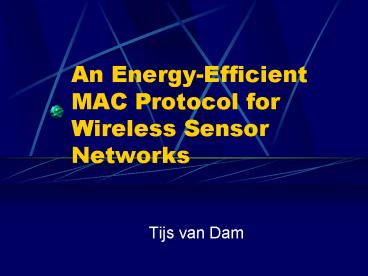An EnergyEfficient MAC Protocol for Wireless Sensor Networks - PowerPoint PPT Presentation
1 / 17
Title:
An EnergyEfficient MAC Protocol for Wireless Sensor Networks
Description:
An Energy-Efficient MAC Protocol for Wireless Sensor ... MAC protocol determines next node to use the medium. Evaluate MAC protocols based on energy usage ... – PowerPoint PPT presentation
Number of Views:314
Avg rating:3.0/5.0
Title: An EnergyEfficient MAC Protocol for Wireless Sensor Networks
1
An Energy-Efficient MAC Protocol for Wireless
Sensor Networks
- Tijs van Dam
2
Quick recap
- MAC protocol determines next node to use the
medium - Evaluate MAC protocols based on energy usage
- Use realistic communication patterns for
evaluation
3
Classic CSMA
- If air is clear, send if receiving, wait
- How do we know when to receive?
- Listen always!
- Listening costs 200x more energy than sleeping
- Not energy-efficient
4
S-MAC protocol
- Fixed active/sleep duty cycle
- Synchronization of active times
- Not optimal for fluctuating message load
- time (events)
- location (important nodes)
5
T-MAC protocol
- Make duty cycle dynamic
- End active time with time-out
- All messages at start of frame
6
T-MAC Protocol (2)
- RTS/CTS/DATA/ACK exchange
- Synchronization not critical
- No increasing backoff fixed contention interval
- Overhearing avoidance
7
Early sleeping problem
A
B
C
D
Ready-To-Send
8
Early sleeping problem
A
B
C
D
!
Clear-To-Send
- B overhears CTS
9
Early sleeping problem
A
B
C
D
?
Data
- B must remain silent
- A times out and goes to sleep
10
Early sleeping problem
A
B
C
D
Ready-To-Send
- When B can send, A is sleeping
- B must wait until next frame (problem!)
11
Early sleeping problem
- A node goes to sleep while another node still has
a message for it - Occurs mostly in asymmetric communication
- uni-directional flow (nodes-to-sink)
- edge of active area
- Throughput decreases dramatically
12
Solutions
- After overhearing a CTS, quickly send a
Future-Request-To-Send - Target node will be awake
- Short pause between CTS and DATA
- When receiving an RTS, ignore and send own RTS
- only when running out of buffers
- only after two tries
- Solutions increase throughput with 100
13
Simulation setup
- 10 x 10 grid network
- Patterns local unicast, nodes-to-sink
- Active areas simulate real-world events
- Realistic nodes
- energy
- radio properties
- DAS2 cluster
- 32 64 cpus
- 2 mins / simulation, gt 40,000 msgs
14
Simulation results
Nodes-to-sink pattern, msglength 20
4.5
CSMA
4
3.5
3
2.5
energy mA / node
2
1.5
1
0.5
0
0
0.05
0.1
0.15
0.2
0.25
0.3
load msg / node / s
15
Simulation results (2)
Event-based local unicast, msglength20
4.5
CSMA
4
3.5
S-MAC
3
2.5
energy used avg. mA / node
2
1.5
1
0.5
T-MAC
0
0
1
2
3
4
5
6
7
8
peak load msg / node / s
16
Real implementation
- Implemented T-MAC on EYES nodes
- FRTS and priority not implemented (yet)
- Seems to work well, no data loss yet
- When idle, radio is off 97.5 of the time
17
Conclusions
- T-MAC reduces energy. A lot.
- Simple implementation
- Simple idea can lead to dramatic improvements
- Paper submitted for SENSYS03
- Infrared demo































